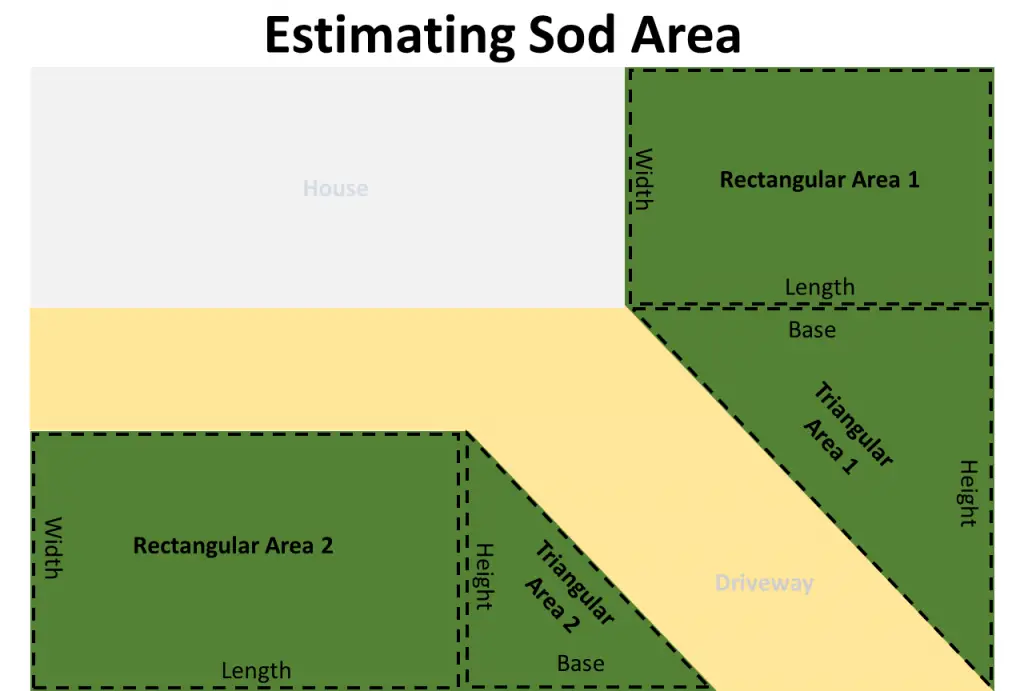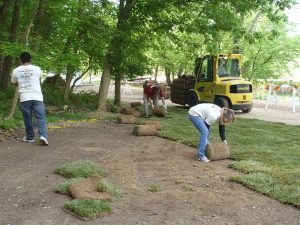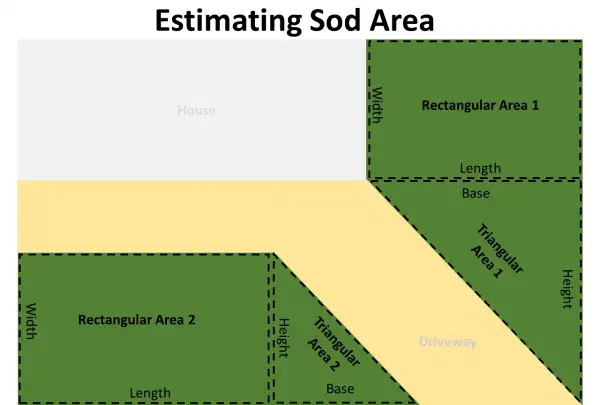This sod calculator will calculate the square feet, rolls, and pallets of sod needed to complete your project.
Just a heads up, this page contains affiliate links. If you buy through them I earn a small commission. If you chose to buy through these links I truly thank you for your support! – Jake
SOD CALCULATOR
How to Use the Calculator
First, enter the size of the roll or piece of sod you will be purchasing. The most common size is probably a 5’x2′ roll (northern US), followed by 16″x24″ pieces (southern US). Many sod farms cut their sod in odd lengths so make sure you call first and ask before figuring out how many rolls/pieces/pallets to order.
Next, enter the area to be sodded or break down your project area into rectangles, circles, and triangles if the area is unknown.
This will be a similar process as laid out on stone coverage calculator page.
The diagram below shows an example of how to break down your project area into simple shapes.

After you have the shapes broken out and the dimensions of each, plug them into the sod calculator and hit calculate.
Pallet Size
Often, 450 square feet of sod is loaded onto a pallet and that is what is used for the purposes of this calculator. This number will vary from farm to farm though, so make sure to check with your supplier if you need an accurate number of pallets.
Sod Weight
Note also that the weight of sod can vary dramatically depending on the moisture content and thickness. 4.5 pounds per square foot is what is used in this calculator as an all around average.
Safety Margin
When ordering sod, it’s always a good idea to order 10% extra in case you end up short or you have some sod that dies before it is planted. This is why these values are also included in the calculated results.

Tips for Laying Sod
General Tips
-
- Lay the sod ASAP after purchasing if working in the summer. Do not let it sit for more than a day or it will overheat and die. In the winter you have some more flexibility.
- If you have to wait, unroll and separate all the pieces, lay them in the shade and keep them moist
- Don’t cover sod with a tarp as it will exacerbate overheating
- Here’s a great guide on sod types to use when deciding which species of grass you want to plant
When to Plant Sod
-
- Sod can be installed anytime of the year if desired
- Spring and fall are ideal since cooler temperatures will keep stacked sod alive longer
- Summer installations can be tricky to do the risk of sod drying out or overheating before installed. Also, it will require extra water after being planted.
How to Prepare Your Yard for Sod
-
- Most sod likes slightly acidic soil so get a soil test like this one completed before you purchase your sod. This will make sure your sod soil will have the right pH and nutrients.

-
- Rototill or dig up the top few inches of soil
- Add compost and any amendments needed and mix in to the existing soil
- Rake the soil level and water it
How to Plant Sod
-
- Start laying sod against a long, straight object like a driveway, fence, or retaining wall
- Lay each subsequent roll butted up tightly next to the previous one
- Stagger each row so seams don’t line up. Do this by starting the even numbered rows with a half length roll.
How to Care for Newly Planted Sod
-
- Keep foot traffic off for a few weeks
- Water daily in the mornings the first week
- During the second week, water every other day
- Water twice during the third week
- Water during dry spells thereafter
- Mow to 2 or 3 inches after grass reaches 3 or 4 inches, respectively
Laying sod for your new yard can definitely be DIY’d if the proper procedures are followed. This sod calculator should be used along with your supplier’s guidelines for an accurate estimate. Most importantly, plant the sod QUICKLY after you bring it home. It will not take long for sod stacked on pallets to dry out, overheat and die. For a more detailed guide on sod installation, check out This Old House’s page.

